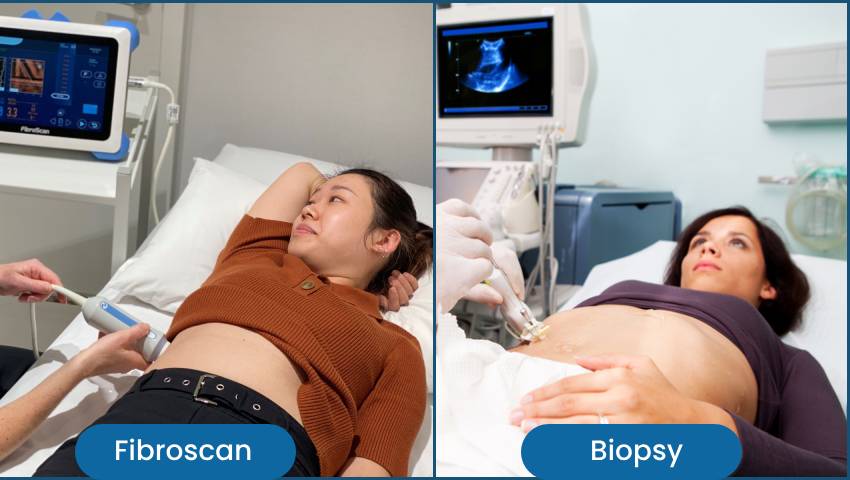
- 11/09/2023
- Kaizen Gastro Care
- 0 Comments
- GI Motility
FibroScan vs. Biopsy: Comparing Liver Fibrosis Assessment Techniques
The liver is a crucial organ that plays a vital role in detoxification, metabolism, and digestion. Unfortunately, it is also susceptible to various disorders, including liver fibrosis, a condition characterized by the excessive accumulation of scar tissue in the liver that can lead to cirrhosis, liver failure, and liver cancer.
Early detection and accurate assessment of liver fibrosis are critical for effective management and treatment. In this blog post, we will delve into two common techniques used for liver fibrosis assessment: FibroScan and liver biopsy, comparing their advantages and disadvantages and explore their key differences between these two methods to help you better understand which one might be suitable for you.
FibroScan: A Non-Invasive Approach:
FibroScan, also known as transient elastography, is a non-invasive test that uses ultrasound waves to calculate the stiffness of the liver. The stiffness of the liver is related to the amount of fibrosis present. Here’s a closer look at its advantages:
- Non-invasive: FibroScan is performed externally, needing no needles or incisions, which makes it slightly painful and less risky compared to a liver biopsy.
- Quick and easy: The method typically takes only a few minutes and doesn’t require hospitalization or sedation.
- Repeatable: FibroScan can be performed at regular intervals to monitor the advancement of liver fibrosis or evaluate treatment effectiveness.
- Wide availability: Many medical facilities offer FibroScan, making it available to a broad range of patients.
However, it’s crucial to note that FibroScan has limitations:
- Limited accuracy: While it provides helpful information, FibroScan results are not as accurate as those from a liver biopsy.
- Influence of factors: Various factors, such as obesity and inflammation, can simulate FibroScan results, potentially leading to inaccurate assessments.
Liver Biopsy: The Gold Standard:
A liver biopsy is a technique in which a small sample of liver tissue is removed and studied under a microscope. This allows the doctor to see the amount of fibrosis present and to diagnose other liver disorders. It is an invasive procedure that can cause some pain and bleeding. A liver biopsy is considered the gold standard for assessing liver fibrosis due to its accuracy. Here are its key advantages:
- High accuracy: Liver biopsy provides a precise evaluation of fibrosis stage and other liver ailments, helping clinicians make tailored treatment decisions.
- Tissue sample: It permits for the examination of liver tissue under a microscope, providing detailed wisdom into the liver’s health.
However, liver biopsy has its downsides:
- Invasive: The technique involves inserting a needle through the skin and into the liver, which can be painful and holds some risk of complications.
- Sample variability: Results can vary depending on the location of the biopsy, potentially leading to sampling errors.
- Recovery time: Patients may undergo discomfort and need a longer recovery period after a liver biopsy.
Comparing the Two Techniques:
While both FibroScan and liver biopsy have their benefits, they also come with some restrictions:
- Accuracy: Liver biopsy is considered more accurate, especially for diagnosing the stage of fibrosis precisely. FibroScan’s accuracy may differ depending on factors like body mass index and liver condition.
- Invasiveness: Liver biopsy is an invasive technique that carries a risk of bleeding and other complications. FibroScan, being non-invasive, eliminates these risks.
- Cost: Liver biopsy can be more costly due to the need for specialized equipment and medical expertise. FibroScan is normally more cost-effective.
- Patient Comfort: FibroScan is more comfortable for patients since it doesn’t involve needles or sedation, unlike liver biopsy.
When Should I Get Tested?
You may need to get tested for liver fibrosis if you have any of the following risk factors:
- Chronic liver condition, such as hepatitis B or C
- Alcohol abuse
- Non-alcoholic fatty liver disease (NAFLD)
- Steatohepatitis
- Obesity
- Diabetes
- Family history of liver disease
Kaizen Gastro Care: Choosing the Right Technique
At Kaizen Gastro Care, patient care and accurate diagnosis are crucial. When it comes to assessing liver fibrosis, the choice between FibroScan and liver biopsy depends on particular patient factors and the clinical scenario. Our experienced team of gastroenterologists and hepatologists in Pune, Maharashtra, carefully assesses each case to determine the most appropriate method for liver fibrosis assessment.
- Individualized Care: We recognize that every patient is special, and we tailor our diagnostic approach accordingly. Some patients may benefit from the precision of liver biopsy, while others may find FibroScan to be a more convenient option.
- Follow-Up and Monitoring: For patients needing ongoing monitoring of liver fibrosis, FibroScan may be the chosen choice due to its non-invasive nature and ability to track differences over time.
Conclusion:
In the assessment of liver fibrosis, the choice between FibroScan and liver biopsy involves a balance between accuracy, invasiveness, and patient comfort. Both techniques have their advantages and limitations, and the decision should be made in consultation with a knowledgeable healthcare provider. At Kaizen Gastro Care, the best gastroenterology clinic in Pune, Maharashtra, our commitment to patient-centered care assures that you receive the most appropriate and effective liver fibrosis assessment for your unique needs. Your liver health is our priority, and we are here to guide you on your journey to optimal well-being.
